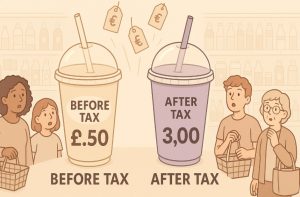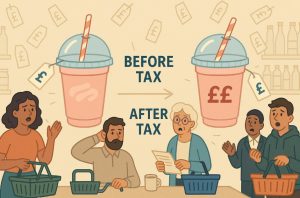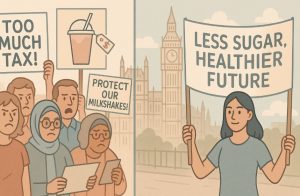Table of Contents
ToggleChancellor Rachel Reeves has unveiled one of her most controversial economic proposals yet: the extension of the UK’s sugar tax to cover milkshake and yoghurt-based beverages.
Labelled by critics as a “stealth tax,” this move could impact millions of Britons, increasing costs at a time when the public is already struggling with record living expenses.
While the government frames the policy as an essential public health intervention, there is growing political and economic debate over whether it will truly achieve its intended goals.
What is the Milkshake Tax and How Will it Affect Consumers?

The milkshake tax proposal seeks to expand the existing Soft Drinks Industry Levy (SDIL), introduced in 2018 to target sugary soft drinks.
Milk-based drinks were originally excluded from the levy to avoid discouraging calcium intake among children and adolescents. However, under the new plan, milkshakes and yoghurt-based beverages that exceed a certain sugar content will now fall under the levy’s scope.
Key changes proposed include:
- Lowering the sugar threshold from 5g to 4g of sugar per 100ml.
- Expanding the levy to cover milk-based drinks previously exempt.
- Potential price increases of up to 24p per litre if companies do not reformulate their products.
The Treasury’s consultation document argues that the nutritional landscape has evolved and that milk-based drinks are no longer major contributors to essential nutrient intake. Instead, these products are seen as significant drivers of excessive sugar consumption.
Why Has Rachel Reeves Proposed Expanding the Sugar Tax?
Labour’s leadership insists that the expansion of the sugar tax is essential for tackling Britain’s growing obesity crisis.
Data shows that childhood obesity rates have nearly doubled from 14.9% in 1993 to 28.9% by 2022, putting enormous pressure on the NHS and increasing the burden on public finances.
The Treasury’s argument for the policy rests on several pillars:
- Public Health: Reducing sugar consumption to curb rising obesity rates.
- Economic Burden: Addressing the £6 billion annual cost of obesity to the NHS.
- Behavioural Change: Encouraging food and beverage manufacturers to reformulate products to contain less sugar.
Rachel Reeves has positioned the milkshake tax as part of a broader strategy of “progressive taxation” that delivers not only fiscal benefits but also improves the nation’s long-term health.
How Does the Milkshake Tax Fit into Labour’s Broader Economic Strategy?

Rachel Reeves’ economic strategy has focused heavily on fiscal prudence, targeting both responsible spending and sustainable revenue generation. The milkshake tax fits this narrative by offering an additional income stream while aligning with Labour’s public health objectives.
However, the move has not come without political cost. Critics, including the Conservative Party and libertarian think tanks, argue that Reeves is reneging on Labour’s 2019 manifesto pledge to avoid raising taxes on working people.
Shadow Chancellor Mel Stride sharply criticised the proposal, accusing Labour of imposing new burdens on households already grappling with high inflation and increased costs of living.
The broader challenge for Labour lies in balancing short-term public dissatisfaction with the potential long-term benefits of the policy.
What Impact Could the Milkshake Tax Have on the Food and Drink Industry?
The proposed milkshake tax will have a ripple effect across the food and drink industry, affecting manufacturers, retailers, and ultimately consumers.
The majority of milk-based drinks available in the UK market currently exceed the proposed 4g sugar threshold, meaning reformulation or price hikes are almost inevitable.
The possible impacts include:
- Increased costs of production as companies reformulate recipes to meet the new standards.
- Potential for higher shelf prices passed on to consumers, particularly affecting low-income households.
- Product innovation, with new low-sugar and sugar-free alternatives entering the market.
- Job implications for companies heavily reliant on the sales of sugary drinks.
While major brands such as Irn-Bru and Ribena may have the resources to adapt, small and medium-sized enterprises could face significant financial strain in meeting the new requirements.
How Have the Public and Political Communities Reacted to the Milkshake Tax Proposal?

Public reaction to the milkshake tax proposal has been sharply divided. Supporters point to the success of the original sugar tax in encouraging healthier formulations and slight reductions in sugar intake. Public health groups such as Action on Sugar have welcomed the expanded levy as a necessary next step.
However, critics argue that:
- The original sugar tax has not significantly reduced obesity rates despite costing consumers an estimated £300 million annually.
- The tax expansion breaches Labour’s election promises and adds financial pressure on already hard-pressed families.
- Sugar taxes have historically had limited success in other countries in reducing obesity or changing long-term dietary behaviour.
Dr Christopher Snowdon of the Institute for Economic Affairs was particularly scathing, calling the original sugar tax a “dramatic failure” that should be repealed rather than expanded.
How Does the Proposed Milkshake Tax Compare to the Existing Sugar Tax?
| Feature | Current Sugar Tax | Proposed Milkshake Tax |
| Products Covered | Soft Drinks (fizzy) | Milkshakes, Flavoured Milk, Yoghurt Drinks |
| Introduced By | Conservative Government (2018) | Labour Government (Proposal 2025) |
| Threshold | 5g of sugar per 100ml | 4g of sugar per 100ml (Proposed) |
| Price Impact | Up to 24p per litre | Up to 24p per litre |
| Revenue Use | School Sports and Health Programmes | Broader Health and NHS Budget |
| Exemptions | Pure fruit juices, milk-based drinks | Likely removal of milk-based exemptions |
The proposed milkshake tax is clearly more aggressive, seeking to capture products that were previously deemed nutritionally beneficial.
Will the Milkshake Tax Realistically Reduce Sugar Consumption and Obesity?
There is limited evidence to suggest that extending the sugar tax to milk-based beverages will significantly reduce overall sugar consumption or obesity rates. Data from the original sugar tax showed:
- A reduction in sugar content among soft drinks by approximately 44%.
- Minimal impact on overall calorie consumption and obesity statistics.
The Treasury hopes that by including more categories of sugary drinks, a broader public health impact can be achieved. However, critics caution that unless the broader food environment also changes, such as through better food labelling, education, and access to healthier options, the tax alone will not suffice.
Behavioural change is complex and often requires a multi-faceted approach beyond just fiscal penalties.
What Challenges Could Arise During the Implementation of the Milkshake Tax?

Several challenges could complicate the rollout and enforcement of the milkshake tax:
- Accurately distinguishing between naturally occurring sugars and added sugars in dairy-based products.
- Securing cooperation from smaller manufacturers who may lack the resources for reformulation.
- Ensuring compliance without creating excessive regulatory burdens.
- Managing public opposition and potential political fallout if the tax is perceived as an unfair cost burden.
The government may also need to engage in extensive consultation with industry groups, public health experts, and consumer advocacy organisations to ensure the policy is both effective and equitable.
Conclusion: Is the Milkshake Tax a Pragmatic Policy or a Political Risk?
Rachel Reeves’ proposed milkshake tax reflects Labour’s ambition to tackle Britain’s public health challenges through fiscal measures. However, whether the policy succeeds will depend heavily on its execution, public reception, and measurable outcomes.
If implemented effectively, it could contribute to healthier consumer choices, reduced healthcare costs, and a more sustainable economy. If mishandled, it risks being seen as another regressive tax that hurts working families during an already challenging economic period.
The next few months, as the Treasury’s consultation progresses, will be critical in determining whether this bold move by Rachel Reeves cements Labour’s commitment to public health or backfires politically.
FAQs About the Milkshake Tax
What is the difference between the milkshake tax and the existing sugar tax?
The milkshake tax would expand the sugar levy to milk-based drinks, which were previously exempt under the original scheme introduced in 2018.
How much could the price of milkshakes increase due to the new tax?
Consumers could see price rises of up to 24p per litre if drinks are not reformulated to meet the lower sugar threshold.
Why has the government lowered the sugar threshold to 4g per 100ml?
Officials believe that the original 5g threshold allowed too many products to narrowly escape taxation, reducing the effectiveness of the policy.
Has the sugar tax been effective so far in reducing obesity?
Evidence shows some reduction in sugar consumption in soft drinks, but obesity rates have continued to climb, leading to scepticism about its overall impact.
Will small businesses be affected more than large corporations?
Yes, smaller producers may struggle more with reformulation costs and compliance challenges compared to major brands with greater resources.
Is Labour breaking its manifesto pledge by introducing this tax?
Critics argue that expanding the sugar tax constitutes a breach of Labour’s promise not to raise taxes on working people.
How does the milkshake tax fit into Labour’s wider public health agenda?
The tax is intended to support broader efforts to reduce NHS costs associated with obesity and promote healthier diets across the UK.




